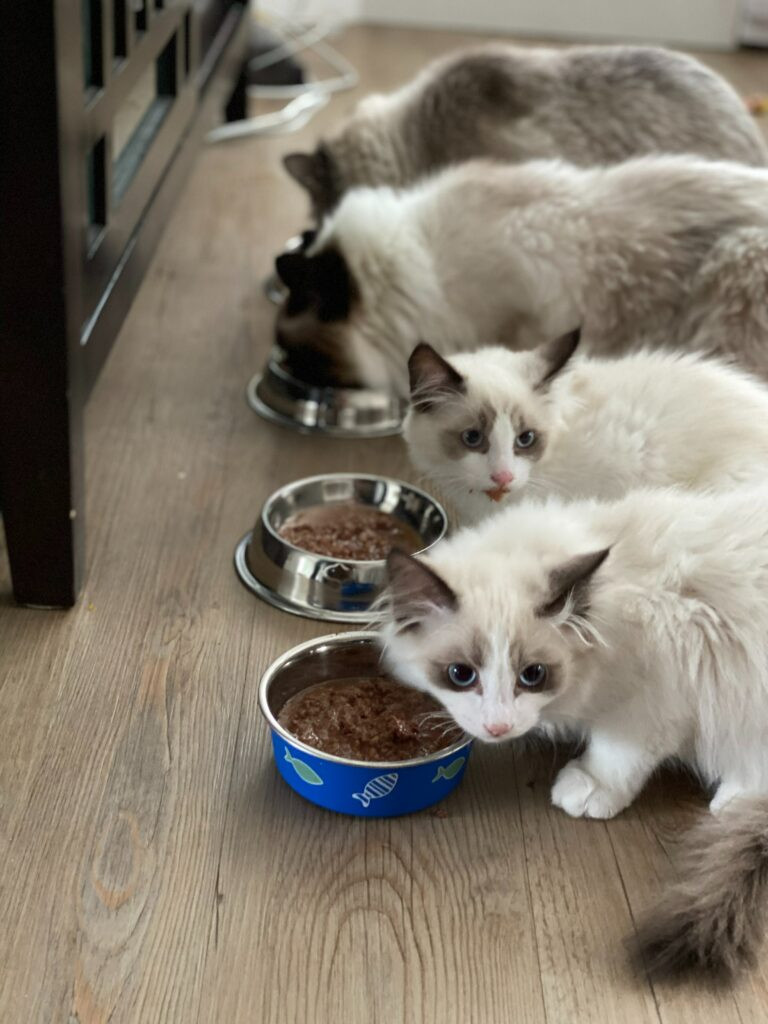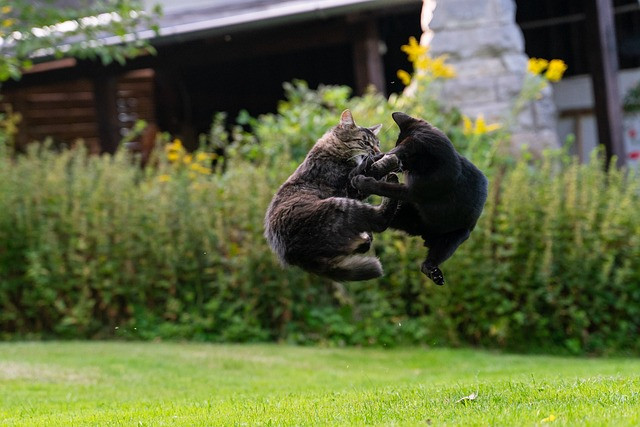Living with multiple cats can be a dream come true, filled with purrs, cuddles, and endless entertainment as they play and groom each other. However, that idyllic picture can quickly turn sour when cat fights erupt. Even the most harmonious feline families can experience sudden and unsettling shifts in dynamics, leading to aggression and conflict. You might be puzzled when your once-peaceful cats suddenly engage in a cat fight, seemingly out of nowhere.
Sometimes, the trigger for a cat fight is obvious, but often, it can be something subtle that you might not even consider problematic. A common scenario many cat owners face involves a vet visit. Imagine two cats who have coexisted peacefully for years. One cat goes for a routine veterinary check-up, perhaps a dental cleaning, or treatment for a minor ailment. Upon returning home, this cat may act slightly different, which is understandable given the stress of a vet visit. It’s important to remember that regular vet check-ups are crucial for maintaining your cat’s health.
Initially, the cats might seem fine, or conflict may arise immediately. But sooner or later, a cat fight breaks out, and you’re forced to intervene to stop the cat fight. In that moment, the relationship between your cats can fracture. Cats that once shared napping spots and engaged in playful antics may now become adversaries, unable to share the same space without tension. Even when they are in the same room, the atmosphere can be thick with stress, a stark contrast to their former camaraderie.
 Four white cats eat out of four bowls.
Four white cats eat out of four bowls.
Witnessing your cats, once companions, turn into what seems like enemies is distressing for any pet owner. The desire to restore peace and harmony to your home, to see your beloved cats return to being friends, is strong. You might wonder if their relationship can ever be repaired and if your home can ever feel peaceful again.
Why Do Cats Engage in Cat Fights?
While the reasons behind cat fights are varied, the scenario described above often stems from feline non-recognition aggression. It might seem strange to us, but cats rely heavily on scent to identify each other. When a cat returns from the vet smelling different due to unfamiliar scents from the veterinary clinic, or even stress pheromones, their housemate may perceive them as a stranger.
Cats are inherently territorial animals, and unfamiliar cats are often viewed with suspicion and hostility. One cat, sensing an unknown entity within their territory, may become defensive. The returning cat, potentially disoriented from the vet visit, might misinterpret this aggression and respond defensively, even if they initially recognized their housemate. This creates a cycle of fear and aggression, even between cats who were once bonded.
Sometimes, cat fights are not triggered by a sudden event but are rooted in pre-existing tensions. Cats might never have truly gotten along due to personality clashes or improper introductions when they were first brought together. In such cases, the underlying fear and anxiety between the cats are continuously reinforced with each cat fight.
 Two cats fighting while flying through the air.
Two cats fighting while flying through the air.
In other instances, cat fights can be triggered by misdirected aggression. If a sudden, frightening event occurs, like a loud noise, a cat might associate the fear with another cat present, even if the other cat was not the source of the scare. This misinterpretation can lead to one cat lashing out at the other in an attempt to alleviate their anxiety or perceived threat.
What Steps Should You Take When Your Cats Are Fighting?
When cat fights become a reality in your home, your immediate instinct is likely to restore normalcy as quickly as possible. In milder cases, the cats might re-establish their equilibrium with minimal intervention. However, in many situations, resolving cat aggression requires time, patience, and a structured approach. To help your cats regain a peaceful relationship, a process known as reintroduction is often necessary.
Understanding Cat Reintroductions
Reintroductions are systematic methods designed to teach each cat that the other is not a threat, and in fact, positive experiences can occur when they are in proximity. When implemented correctly, reintroductions often yield successful results, but it’s important to understand that the process can be lengthy, sometimes spanning months before a semblance of normalcy is restored. The more frequent and intense the cat fights, the more challenging the reintroduction process can become. In some unfortunate situations, despite best efforts, rehoming one of the cats might be the most compassionate solution.
Reintroductions essentially involve restarting the cat introduction process from the beginning, but with greater precision and a slower pace. Crucially, complete separation of the cats is required throughout the reintroduction, except during carefully controlled interaction sessions.
Given the time commitment and emotional toll reintroductions can take on pet owners, navigating this process alone can be daunting, even with detailed guidance. Fortunately, expert help is available. Reintroductions are a frequent reason why cat behaviorists are consulted. If you are committed to working through a reintroduction and restoring peace in your multi-cat home, professional guidance can be invaluable.
Exploring Alternatives to Reintroduction
If embarking on a full reintroduction immediately feels overwhelming, there are alternative strategies you can consider to mitigate cat fights. While their success rates vary, they might be worth exploring, particularly for less severe cases of cat aggression. Seeking professional advice from a cat behaviorist can help you determine if a reintroduction is truly necessary or if alternative approaches might suffice.
Pheromone diffusers are often suggested as a remedy for cat conflict. While they are unlikely to cause harm, their effectiveness in resolving established cat fights is often limited. You can try them, but it’s wise to manage expectations.
Addressing the Root Cause of Cat Fights
Identifying and resolving the underlying cause of the cat fights is a more effective alternative. Avoid using punishment or methods that scare your cats, as this can exacerbate their fear and aggression towards each other. For example, if resource competition is fueling the conflict, such as both cats vying for the same cat tree, providing additional resources can be beneficial. Adding a second cat tree, extra feeding stations, or more litter boxes can reduce competition and territorial disputes. While this might prevent further cat fights, addressing any existing negative associations between the cats may still require additional steps.
Temporary separation can also be a useful strategy in less severe cases. Separating the cats for a few hours or even a few days can give them a break from the tension and allow stress levels to subside. During separation, ensure each cat has access to all essential resources – food, water, litter box, and comfortable resting areas. It’s vital that the cats are completely unable to see each other during this period. Using draft guards under doors or window film can prevent visual contact and reduce the chance of continued interaction through barriers.
Actions to Avoid When Cats Fight
Certain approaches to cat fights can be counterproductive and even harmful. A outdated notion is to let cats “fight it out.” This is strongly discouraged. Allowing cat fights to escalate risks serious injuries to your cats and does not guarantee they will resolve their issues. Intervention and a proactive approach are always preferable.
Another common but misguided suggestion is to feed cats close together to create positive associations. Current feline behavior guidelines actually advise against this practice in cases of inter-cat tension. Cats generally prefer to eat separately, and forced proximity during feeding can create more stress and anxiety. While cats might tolerate each other for food, it doesn’t necessarily translate to improved long-term relationships. It’s best to avoid forced communal feeding.
If your cats are actively engaged in a cat fight, it’s crucial to safely interrupt the fight without putting yourself at risk of injury. Never place your hands directly between fighting cats, as this greatly increases the risk of cat bites. Use safe methods to break up a cat fight, such as making a loud noise, throwing a blanket over them, or using a water spray (used cautiously and not directly at their faces).
Is There Hope for Cats That Fight?
One of the most frequent questions from concerned cat owners is whether there is hope for their fighting cats. While various factors can influence the likelihood of cats tolerating each other, and complete reconciliation isn’t always guaranteed, in many cases, there is indeed hope for improvement. Realistic expectations are key; a quick fix is unlikely. Sometimes, with environmental adjustments and stress reduction, the situation can improve naturally. In other cases, a structured reintroduction or behavioral modification plan is needed. With patience, consistency, and the right approach, many households can transition from a state of constant feline conflict to a more peaceful environment, free from the unsettling sound of cat hisses and aggression.
Need Professional Guidance for Your Fighting Cats?
Schedule a Behavior Consultation to receive expert help and personalized strategies to address cat aggression and restore harmony in your multi-cat home.

